Menus
- Born for burnouts
- "The Yamaha Vmax remains a moody woman!"
- With 145 hp the most powerful production motorcycle in the world
- The air scoops and the tank above the engine are dummies
- The Yamaha Vmax is not a corner robber
- Easy double-digit figures in terms of consumption
- ZL 1000 was offered unchanged for 2 years
- Six courses would really not be necessary
- Yamaha Vmax (1985-2002)
- Kawasaki ZL 1000 (1987-1988)
- Opinions
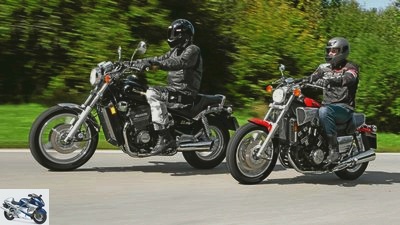
Stefan Wolf
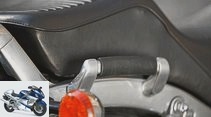
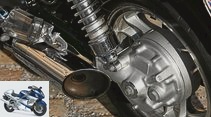
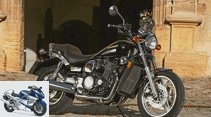
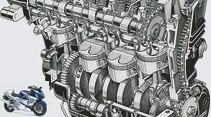
38 photos

1/38
The “new” Vmax, in the range since 2008, also shows off superlatives in terms of performance, acceleration and impressive appearance.

Stefan Wolf
2/38
Stable, laterally arranged bars should enable the passenger to hold on – probably impossible at full acceleration.
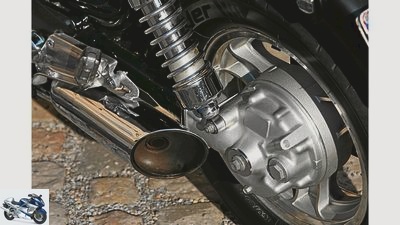
Stefan Wolf
3/38
Only a subtle pithy four-cylinder sound escapes from the mufflers in the sidepipes look. The cardan shows typical drive reactions.

Stefan Wolf
4/38
The ZL value of 7.2 seconds for the torque measurement in the last gear remained unbeaten for many years.
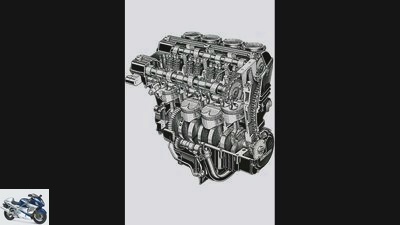
Stefan Wolf
5/38
The ZL engine, trimmed to 998 cm³ by means of a larger bore and stroke, is based on the high-revving GPZ 900 R four-cylinder (picture).
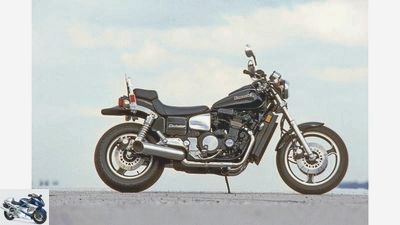
Stefan Wolf
6/38
1985: The 105 hp ZL 900 with the modified GPZ engine, produced in the USA, was designed for the American market and only remained in the range for two years.

Stefan Wolf
7/38
1986: The GTR 1000 tourer served the ZL 1000 as a donor of the engine and drive train. The carburettor and gear ratio were adjusted, the balance shaft was omitted on the ZL.
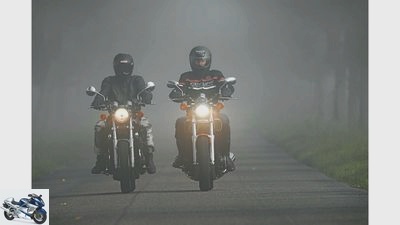
Stefan Wolf
8/38
Bad bikes: When you get on, almost everyone mentally mutates from the harmless one
Dr. Jekyll to sinister Mr. Hyde.

Stefan Wolf
9/38
Who is the beauty, who is the beast? Appearance is a matter of taste.
In terms of character, the Kawasaki could be described as a sinewy, ready-to-jump big cat, the Vmax more like a wild bull.
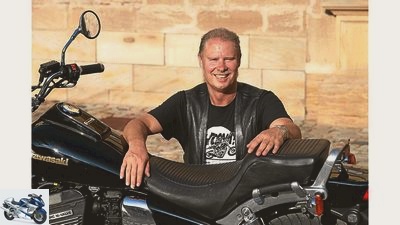
Stefan Wolf
10/38
Dirk Haidvogl: owner of the Kawasaki ZL 1000.
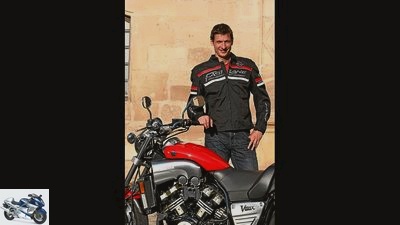
Stefan Wolf
11/38
Ralf Epple: owner of the Yamaha Vmax.
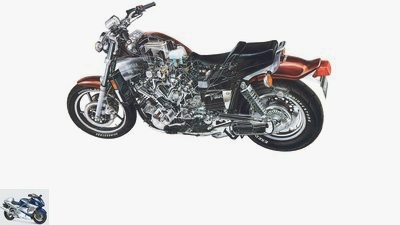
Stefan Wolf
12/38
When the servomotor-controlled throttle valves in the connecting ducts begin to open at 6000 rpm, the signs point to a storm. At 8000 rpm these are fully open, at 9000 rpm up to 145 hp pull the cardan.
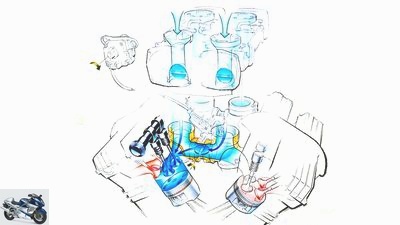
Stefan Wolf
13/38
V-boost system.
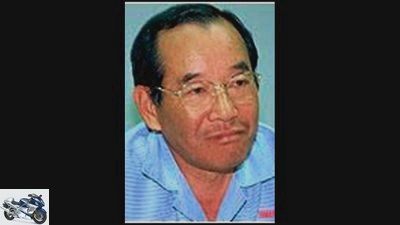
14/38
30 years of Yamaha Vmax: Project manager Araki had the original idea for the Vmax during a trip to the USA, …
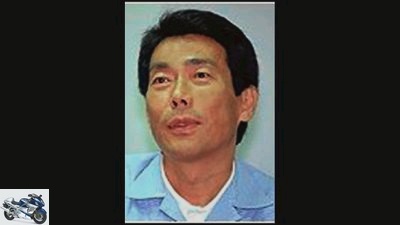
15/38
… Engine developer Ashihara provided the power of the V4 engine.
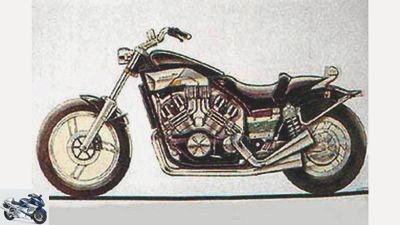
16/38
30 years of Yamaha Vmax: Design from 1984.
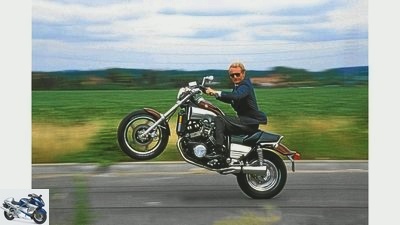
17/38
30 years of Yamaha Vmax: Jean-Claude Olivier.

18/38
30 years of Yamaha Vmax: Brochure from 1985. Vmax drivers can all do this one magic trick: turn rubber into smoke. Almost unavoidable at full throttle in the first. It is well known that many converters and refiners took on the Vmax …
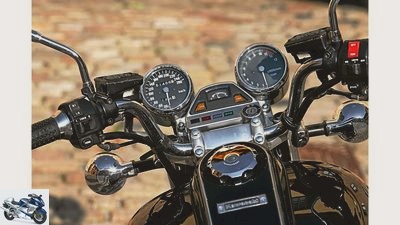
Stefan Wolf
19/38
Classic chrome round clocks characterize the cockpit and frame the central console with the small fuel gauge.
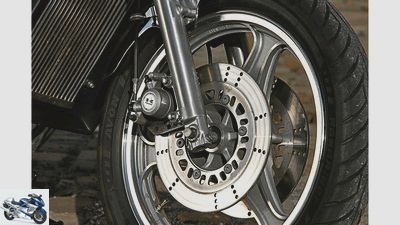
Stefan Wolf
20/38
The unspectacular front brake with 280 mm discs was always considered blunt and rather toothless. Perhaps in order not to overbrake the ultra-narrow 100 mm front tire so easily?
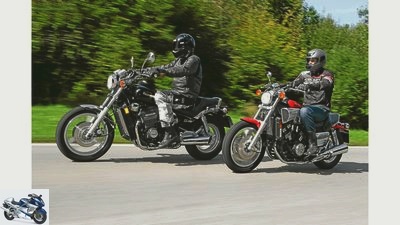
Stefan Wolf
21/38
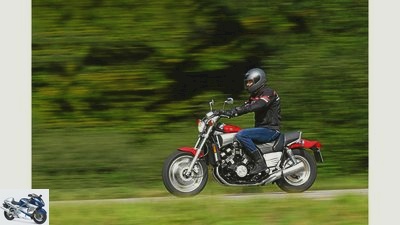
Stefan Wolf
22/38
Yamaha Vmax: Performance makes you cool: The attitude “I could at any time, so I don’t have to” quickly emerges.
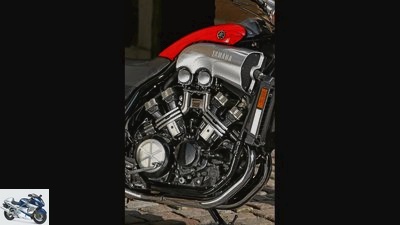
Stefan Wolf
23/38
Striking and well-known: the large aluminum air scoops are only blenders and have no function.
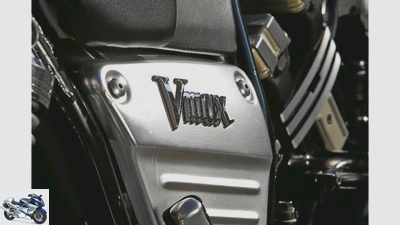
Stefan Wolf
24/38
Know where: under the seat cushion that can be folded forward …
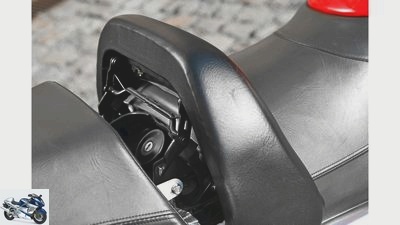
Stefan Wolf
25/38
… hides the access to the meager 15 liter tank.

Stefan Wolf
26/38
The brakes with four-piston calipers and perforated 298 mm discs (from 1993) from the FZR 1000 represent a real improvement.
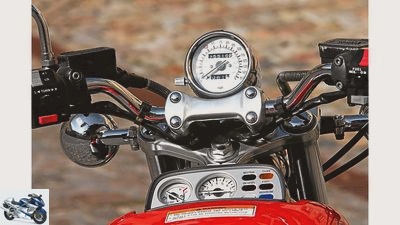
Stefan Wolf
27/38
The speedometer (here with a mileage scale) sits enthroned in the center and high up, while the small rev counter shares the space with the temperature display and the control lamps in the tank console.
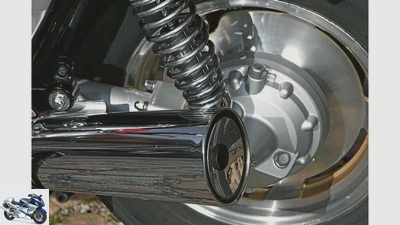
Stefan Wolf
28/38
The low-maintenance cardan transmits up to 145 hp to the often overburdened rear wheel.
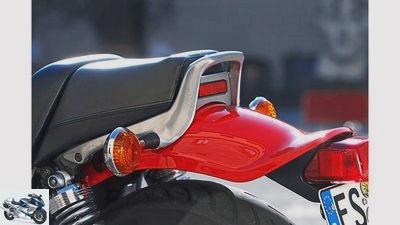
Stefan Wolf
29/38
The design of the rear fender shows the typical signature of the US market initially targeted.
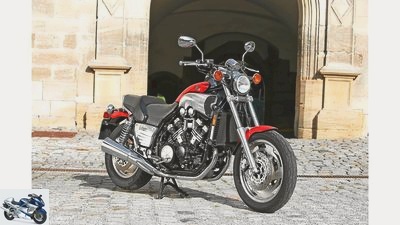
Stefan Wolf
30/38
Egli: “Despite improvements in 1993, Vmax remains a moody woman who wants to be treated properly”.
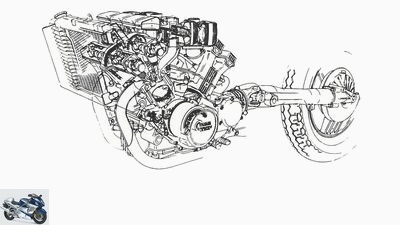
Stefan Wolf
31/38
The XVZ 12 engine (without boost system, 97 hp) serves as the basis for the modified Vmax power pack.

Stefan Wolf
32/38
1984: The 97 hp, long-life V4 engine of the clad Supertourer XVZ 12 served as the basis for the i.a. Vmax engine trimmed to 145 hp via V-Boost. Price: 17,700 marks.
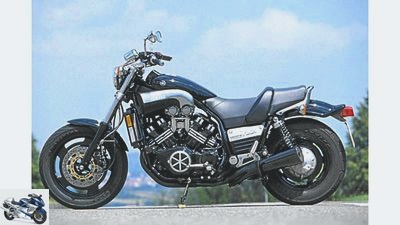
Stefan Wolf
33/38
1996: With the 2EN model, Yamaha finally officially offers the Vmax (without V-Boost) in Germany. Only available with 98 hp ex works, open at least 120 hp. Price: 18,590 marks.

Stefan Wolf
34/38
Kawasaki ZL 1000: The briefly translated torque bull could be
start off without any problems even in sixth gear.

Stefan Wolf
35/38
Inconspicuous: The straightforward, water-cooled row quad has above all inner values.
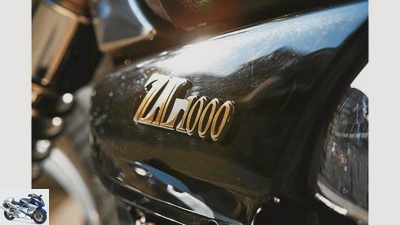
Stefan Wolf
36/38
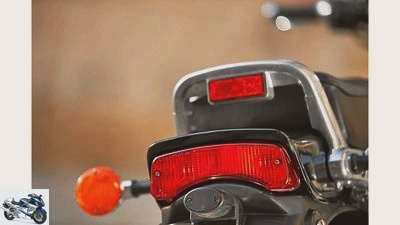
Stefan Wolf
37/38
The US market is also cruising with the design of the ZL 1000 rear light.

38/38
… Here is a shrill piece of jewelery that is for sale at Egli.
On the move with Kawasaki ZL 1000 and Yamaha Vmax
Born for burnouts
Content of
A legend turns 30, and thus a classic car, but the Yamaha Vmax is far from being scrapped. The iconic power bike tenses its muscles again when riding with its only true competitor at the time, the Kawasaki ZL 1000.
Born to burn – born for burnouts. When raw power meets overburdened rear tires. The two muscle bikes Vmax and ZL 1000 were the measure of all things in the mid-1980s, had endless steam and ironed out everything in terms of quarter-mile sprints and pull-throughs that could compete with them. Built to cover the 400 meters as quickly as possible, to sprint from traffic light to traffic light, acceleration is everything, every tenth, no, every hundredth counts.
Buy complete article
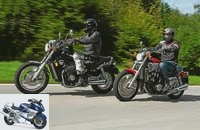
On the move with Kawasaki ZL 1000 and Yamaha Vmax
Born for burnouts
Both Yamaha Vmax have so much pressure that they could start in last gear and anyway, from city speed, they could do everything in this gear at any time. The left foot has a break, thanks to the torque. As early as 1985, Yamaha demonstrated with glee the popular trick of how to turn rubber into plenty of white smoke at the presentation.
"The Yamaha Vmax remains a moody woman!"
After all, they wanted to put the image of the Yamaha Vmax in the right corner from the start. The new one should not be a comfortable everyday bike, nor a cruiser or chopper, even if it was included in some lists under this heading within Yamaha. It should be a macho bike, built for real guys who were man enough to tame the beast. Anyone who drove the Yamaha Vmax was anything but no wimp. Until 1996, Yamaha considered whether the official import and sale in Germany would be worthwhile and from this year finally brought the muscle bike across the pond.
However, due to the voluntary self-restriction of the manufacturers to 98 hp prevailing at the time, the Yamaha Vmax was only available in this country as a heavily tamed, not to say castrated, throttle version. Because the German version had to get along without V-Boost and the already expensive conversion kit is no longer available, the 2EN version can only be dethrottled to a maximum of 120 hp today, which is done by means of a different carburetor nozzle and removal of the throttle valve stop. If you don’t want to do without the kick of the booster and enjoy the full power of 136 or 140 hp, you still have to get a gray import from Canada or the USA.
At the time of its introduction in Germany, the Yamaha Vmax had already had its few model maintenance measures behind it. There was an improved gearbox as early as 1987, and in 1993 Yamaha gave its macho bike a more stable fork with 43 instead of 40 millimeter thick stanchions and a new brake system borrowed from the FZR 1000. The four-piston calipers now bite into perforated 298 mm discs and keep the mighty load in check much better on the wild ride than the earlier system with two-piston fixed calipers and internally ventilated 282 mm discs. For the wild ride, not only the brute thrust of the V4, which is good for wildly lurching acceleration orgies, but unfortunately also the chassis weaknesses supplied as standard from the factory. Tuning and suspension specialist Fritz W. Egli once announced: “Despite improvements, the Vmax remains a moody woman who wants to be treated properly.”
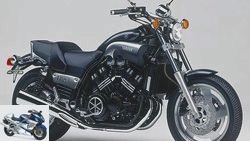
Used purchase
Second-hand advice Yamaha Vmax (1985 – 2010)
The Yamaha muscle bike as a used one
read more
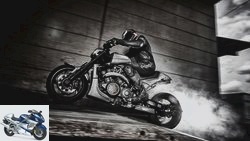
Modern Classic
Limited Edition Kodlin-Yamaha Vmax
Unreason in perfection
read more
With 145 hp the most powerful production motorcycle in the world
Courage and driving skills alone are not enough. What Egli meant and put it into practice very early on are sensible modifications to parts with less play and elimination of manufacturing tolerances. Not only the Swiss, who, by the way, helped the already not weak engine to over 200 hp by means of compressor ventilation, developed into an important contact point in the Vmax scene, especially Emil Schwarz earned a reputation as the specialist par excellence when it comes to it is about teaching manners to the chassis of the Yamaha Vmax. Many of the specimens that can be found on the streets today should ensure significantly less sweaty driving situations thanks to the more precise mounting of the steering head and swing arm and calm the nerves of many drivers. After all, the engine with its performance characteristics already provides enough adrenaline.
In fact, the Yamaha Vmax, with its open 145 hp, was the world’s most powerful production motorcycle at the time. The Yamaha still lives from this reputation and the myth that has arisen around the mighty bike. Even if significantly lighter super athletes have long been showing off with significantly more horsepower, the Vmax can still have a positive say today when it comes to pure sprinting ability and completing the quarter mile. It probably has something to do with the testosterone-impregnated appearance and the macho attitude that surrounds the Yamaha Vmax and which you can hardly escape even with the most rational approach. There is almost a kind of transformation taking place. Even a peaceable linnet at only one seventy would automatically mutate into a bull-necked, extensively tattooed bouncer in a bomber jacket as soon as he took his place on the V4 monster and kicked off the primeval engine. I, too, can hardly escape this inner transformation and I am glad that today we are only moving in rural areas for the photo rides and the experience with the Yamaha Vmax, and not in the city center. This leaves me with the presumably embarrassing re-transformation when stepping down from Mr. Hyde – plop – to Dr. Jekyll saved in front of an audience.
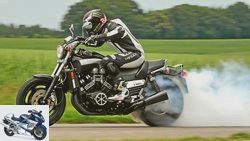
classic
Yamaha Vmax
Dream bike election 2014: 8th place
read more
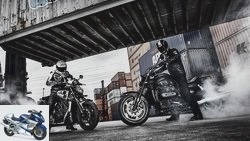
Chopper / cruiser
Triumph Rocket III Roadster and Yamaha Vmax in the test
Motorcycles with a large displacement in a comparison test
read more

motorcycles
Comparison test: macho bikes
Ducati Diavel, Yamaha Vmax and CR&S DUU in the test
read more
The air scoops and the tank above the engine are dummies
Ralf Epple, the owner of our photo copy, doesn’t want to conform to the cliche of the typical Vmax driver at all. The 44-year-old is a rather reserved, friendly fellow and, as he himself states, a very correct person who adheres to the speed limits. Anything but a wild daredevil who lets the pig out with the Japanese primeval creature. His Yamaha Vmax would also be a shame for that, because the mechanical engineer bought it new in 1994 and takes meticulous care of his seasonal motorcycle, which today only has around 25,000 kilometers, pardon me, miles on the clock. After all, it is a US model, type 2WE with open 140 hp, with a mileage speedometer, of course. Even if black would better suit this bike, which is by definition bad, the red paintwork of our Foto-Max also looks good.
So now I have the honor and the duty to get to the bottom of the myth and character of the Yamaha Vmax. The oil is warm, so I can ignore the choke button for the cold start. But that wouldn’t be an issue either, says Ralf, “the Vmax always starts reliably”. Well then, sit up, lift the 280 kilograms off the main stand, feel the mass and keep it in balance. The motor on wheels, as it was reverently referred to by fans and maliciously by envious and mockers, has a high center of gravity, which at first doesn’t matter as long as I don’t have to maneuver. Cozy, almost fluffy, oh well, I slouch, better in the deep, lushly padded saddle, almost sofa-like. To the rear I find support thanks to the fat bulge that separates the driver’s seat from the pillion seat and can be unlocked with a small lever and folded forward to give access to the tank. That’s right, the painted little something high above the engine is just a dummy tank, the stingy 15 liters of fuel slosh favorably in the barrel under the seat bench. I’ll be happy about the seat support later when accelerating hard, and the mock-up also includes the distinctive and legendary side air scoops – they are also just for show and only serve the opulent styling. Make thick cheeks, but are just blenders.
All articles about the Yamaha Vmax
The Yamaha Vmax is not a corner robber
The engine is certainly not a blender, which is still grumbling with a slightly hoarse V4 sound. On the handlebars, which I would like to have a little wider, my arms take a relaxed position, my feet rest on the notches that are not too far forward – the entire ergonomics are somewhere between cruiser and naked bike, not too passive, but very relaxed straight back. The V4 decently takes on the gas, and the Yamaha Vmax can be set gently in motion. Pious as a lamb, as if it couldn’t cloud a little bit of water. The combination of a relatively flat fork, a narrow, large front wheel and a small, wide rear wheel makes the Yamaha Vmax a little wobbly when driving slowly around corners, but we remember what it was originally made for: full throttle straight ahead, from A to B as quickly as possible. Take it, take it, first of all achieve free running and enjoy the gentle thrust from less than 2000 tours. Evenly, but energetically at all times, the Yamaha Vmax pushes out from below, the confident feeling of “I could anytime, so I don’t have to” arises. Performance makes you cool.
I must also adopt a tolerant attitude if I expected real comfort. As soft and spongy as expected / feared, the performance is not at all casual. Of course, when you brake hard, it dips into the front, but the fork and struts do their job rather unwillingly and rumble dryly over holes and transverse joints.
A long driveway comes into view, the Yamaha Vmax is not a corner robber, that much becomes clear here at the latest. The already willing front wheel and the tenaciously resisting rear wheel do not seem to be entirely in agreement about the radius of the curve and the lean angle in which it should be completed. The front tilts in, the rear wants to be pressed with force. Okay, in the course of the trip I’ll get used to it, but now first take the four-lane main road and open fire. Briefly shift down a gear to get into the booster area and – hossa! – there it comes, the long-awaited effect. The threshold of 6000 rpm is passed, at 7000 rpm it becomes clearly noticeable, it pulls my arms out and presses me into the seat support. Under wonderful V4 tubes, the comparison with a stag in heat is once again rightly quoted here, the 140 horses that have gone wild push ahead as if there was no tomorrow. Looking back from the too small tachometer on the road, shifting, stopping the accelerator, shifting, and we’re already moving in the speed range that could easily cost me the rag for half a year or more if things went really bad. So I’ll let it be good for now, from 220 it will be in the long run anyway, says Ralf, really exhausting to cling to the handlebars.
Easy double-digit figures in terms of consumption
It goes without saying that double-digit values were flared here in terms of consumption. The Yamaha Vmax was never designed as a miracle of savings and after tests at that time with values between six and eleven liters / 100 km, it was also not known. Rather, for their sprinter qualities and brute force. Draft? At the latest when I was working out the idea for this comparison, something rang for me. Not only was there only one serious competitor for the Vmax in the mid-1980s, no, a value was already burned into my memory back then that was to remain a record for many years. The value for the pull-through measurement from 60 to 140 km / h in last gear. And with 7.2 seconds the Kawasaki ZL 1000 was ahead. Even before the Yamaha Vmax (8.9 s). Nevertheless, the ZL has never achieved this cult status of the Vmax, even if both its “little” sister and predecessor, the ZL 900, and the ZL 1000 enjoy a manageable but very loyal fan base.
The Elli, as the Eliminator models are affectionately known, are perhaps not spectacular enough with their good, perhaps all too normal, in-line four-cylinder engines derived from the high-volume athletes, their stylish dragster appearance with long wheelbase and angled end pots not shrill enough. The 900, the Kawasaki ZL 1000 even more, had enough steam for official driving performance. And the four-cylinder had already achieved a good reputation as a reliable big block since its appearance in the GPZ 900 R in 1984. So at Kawasaki they remembered not to leave the Yamaha Vmax the field of the powerful macho bike and quarter-mile racer without a fight and to trim the in-line four for torque for this purpose. The matching short translation, a fat 160 cm rear tire – the series dragster is ready. The 900 series only found its way to Germany as a US import, the 1000 series was officially offered in this country from 1987, but disappeared from the model range after two years.
ZL 1000 was offered unchanged for 2 years
Dirk Haidvogl, longtime ZL fan and webmaster of the fansite www.zl-treffen.de, has long been fascinated by the fascination, he owns two copies of the Kawasaki ZL 1000. He once bought one of them and has now driven 135,000 kilometers The second, our photo bike with a good 51,000 kilometers on the clock, he got hold of a good three years ago and only moves it sporadically. The Kawa is in its original condition, except for small details, such as braided steel brake lines and a radiator grille. There were never any variants of the ZL: It was offered unchanged for two years, in this country with 100, in the unthrottled foreign version with 110 hp. The engine, I admit, is still familiar to me from my GPZ 1000 RX, which I owned many years ago. However, the original 125 hp four-cylinder had to endure a few changes for use in the GTR 1000 tourer and the ZL 1000: It got tamer camshafts; The carburetor, gearbox and final transmission have been modified. In addition, the ZL has a larger water cooler, instead of the oil cooler, and the balance shaft is also missing from the Kawa drag bike.
Six courses would really not be necessary
This does not affect the running culture much, that much becomes apparent quickly. After the cold foursome is started with a choke aid, Kawa-typical cheering for a short while and needs to be readjusted immediately, the engine decays into a subtle row foursome with a slightly howling overtone. The Kawasaki ZL 1000 sets in motion with a few throttles of the gas, a short warm-up phase and smoothly. The posture in the deep, very wide saddle feels very similar to that on the Yamaha Vmax. Clutch and brake levers that protrude far require large paws, while the engine requires only a little gas. Practically from idle, it delivers cleanly available power, then it increases evenly over the entire speed range without the explosive kick of the Vmax. If it had to, up to the maximum speed of 10,400 rpm, with the 100 hp already being reached at 9,000 tours. But whoever shifts at 7000 rpm is very quick and still stress-free on the road, without the feeling of squeezing the kawa. Six gears would really not be necessary, the silky torque bull could be started even in the last gear. I try it out: arterial road, city limits, speedometer 60 in sixth gear – I open the gas and wait to see what happens. The engine depends very directly on the gas, the four-wheeler presses its power through the cardan shaft onto the 160 mm rear tire and pulls my arms out, like some other power bikes not even in third gear. As if pulled on a rubber band, the ZL clicks forward, more evenly, less spectacularly, but still more efficient than the Yamaha Vmax. The legendary pull-through value of 7.2 seconds, that’s how it feels. Accompanied by the angry hiss of the four-cylinder, a laboriously domesticated sports engine.
Incidentally, a short sprint from traffic light to traffic light in the first three gears reveals the Kawa’s much more pronounced cardan reactions. More noticeably than with the Yamaha Vmax, the rear rises and then the suspension hardens. Overall, the ZL is softer and more comfortable, falls much more readily in corners and feels much more than the measured ten kilos lighter than the Vmax. At most, the brakes seem a bit duller, less snappy and curb the pilot’s burgeoning sporty driving style. But why riot through curves in a sporty way? If you have so much steam in the boiler on the straight, you can take it a little easier in curves.
Yamaha Vmax (1985-2002)
Stefan Wolf
Price 1986: approx. 16,000 marks.
Data (type 1UT)
Engine: Water-cooled four-cylinder, four-stroke, 70-degree V engine, two overhead camshafts, four valves per cylinder, actuated via bucket tappets, displacement 1198 cm³, output 107 kW (145 PS) at 9000 / min, torque 122 Nm at 7800 / min
Power transmission: Multi-disc oil bath clutch, five-speed gearbox, cardan drive
Landing gear: Double loop tubular steel frame, telescopic fork at the front, Ø 40 mm, two-arm swing arm made of steel, two spring struts, cast aluminum wheels, tires 110/90 V 18 at the front, 150/90 V 15 at the rear, double disc brake at the front, Ø 282 mm, disc brake at the rear Ø 282 mm
Mass and weight: Wheelbase 1590 mm, weight with a full tank of 280 kg
Driving performance: Top speed 239 km / h, acceleration 0 to 100 km / h in 3.3 s
Technology: The Yamaha Vmax (unfortunately) fulfilled the cliche of the muscle man who can hardly walk with strength from the start. With a very healthy heart, the 145 hp, problem-free V4 engine, but overburdened or plagued by overly large manufacturing tolerances. The only 97 hp 1198 cm³ four-cylinder, borrowed from the well-behaved XVZ 12 touring bike, had to endure a few tuning measures for use in muscle bikes, but this does not detract from its robustness and durability.
With larger valves and reinforced valve springs, sharper camshafts, lighter pistons and a revised crankshaft, one was already a little further, but the full thrust and the full 145 hp were only achieved with the specially developed V-Boost system. A servomotor controlled by the ignition ensures from 6000 rpm that the throttle valves increasingly open the cross-section of the connecting pipes between the intake ducts of the two right and left cylinders so that they are fully open at 8000 rpm. Then practically every cylinder is supplied with mixture via two carburettors. However, not all versions of the Yamaha Vmax have the booster.
The reliable V4 is only occasionally haunted by electronic problems, there is talk of destroyed regulators, defective alternators and ignition control units. The chassis was the main source of concern. Manufacturing tolerances in the steering head and swing arm bearings led to disruptive play and, together with the partially unbearable wheel alignment with up to 15 millimeters of play, resulted in lousy straight-line stability. Specialists like Egli and Emil Schwarz recognized the gap and immediately offered help on a broad front. So you can still get the package “steering head bearing, triple clamp set and backlash-free swing arm bearing bolts with installation and track measurement” for the Yamaha Vmax from Emil Schwarz for 1100 euros and should then have some peace and quiet.
Used check: After choosing the desired model (with or without V-Boost), the main focus is of course on the original condition or the sensible, permissible and registered chassis conversions. If everything is still in its original condition, you should plan a budget for the chassis improvements. Models from 1987 already have an improved gearbox, from 1993 there was a new, stiffer fork and, above all, the more snappy brake from the FZR 1000. The impression gained from the previous owner can also be important here – hot-headed permanent burnout kings can even do that sturdy gearbox and the cardan of the Yamaha Vmax.
Market: The number of vehicles registered in Germany is difficult to quantify. Around 3,000 gray models were sold until 1995, and around 7,000 officially offered by Yamaha Germany from 1996 onwards. Plus the other gray bikes imported in the meantime. The prices range from the less popular German model (Yamaha Vmax without V-Boost) from around 3500 euros to the top-quality imported model with V-Boost and open power for around 7000 to 9000 euros.
Specialists
Emil Schwarz
Telephone 0 71 81/99 52 90
www.emilschwarz.de
Egli Motorradtechnik AG
Tel .: 00 41/5 66 67 23 6000 41/5 66 67 23 6000 41/5 66 67 23 6000 41/5 66 67 23 6000 41/5 66 67 23 6000 41/5 66 67 23 6000 41/5 66 67 23 6000 41/5 66 67 23 6000 41/5 66 67 23 6000 41/5 66 67 23 6000 41/5 66 67 23 6000 41/5 66 67 23 6000 41/5 66 67 23 6000 41/5 66 67 23 6000 41/5 66 67 23 6000 41/5 66 67 23 6000 41/5 66 67 23 6000 41/5 66 67 23 6000 41/5 66 67 23 6000 41/5 66 67 23 6000 41/5 66 67 23 6000 41/5 66 67 23 6000 41/5 66 67 23 6000 41/5 66 67 23 6000 41/5 66 67 23 6000 41/5 66 67 23 6000 41/5 66 67 23 6000 41/5 66 67 23 6000 41/5 66 67 23 6000 41/5 66 67 23 6000 41/5 66 67 23 6000 41/5 66 67 23 6000 41/5 66 67 23 6000 41/5 66 67 23 6000 41/5 66 67 23 6000 41 / 5 66 67 23 6000 41/5 66 67 23 6000 41/5 66 67 23 6000 41/5 66 67 23 6000 41/5 66 67 23 6000 41/5 66 67 23 6000 41/5 66 67 23 6000 41 / 5 66 67 23 6000 41/5 66 67 23 6000 41/5 66 67 23 6000 41/5 66 67 23 6000 41/5 66 67 23 6000 41/5 66 67 23 6000 41/5 66 67 23 6000 41/5 66 67 23 6000 41/5 66 67 23 6000 41/5 66 67 23 6000 41 / 5 66 67 23 6000 41/5 66 67 23 6000 41/5 66 67 23 6000 41/5 66 67 23 6000 41/5 66 67 23 6000 41/5 66 67 23 6000 41/5 66 67 23 6000 41/5 66 67 23 6000 41/5 66 67 23 6000 41/5 66 67 23 6000 41/5 66 67 23 6000 41/5 66 67 23 60
www.egli-racing.ch
Clubs and forums
www.dievmax.de
www.vmaxoutlaw.com
www.vmaxxers.net
You’ll need Skype CreditFree via Skype
You’ll need Skype CreditFree via Skype
You’ll need Skype CreditFree via Skype
You’ll need Skype CreditFree via Skype
You’ll need Skype CreditFree via Skype
You’ll need Skype CreditFree via Skype
Kawasaki ZL 1000 (1987-1988)
Stefan Wolf
Price 1987: 13,990 marks.
Data (type ZL 1000-A1)
Engine: Water-cooled four-cylinder four-stroke in-line engine, two overhead camshafts, four valves per cylinder, operated via rocker arms, displacement 998 cm³, output 74 kW (100 hp) at 9000 rpm
Power transmission: Multi-disc oil bath clutch, six-speed gearbox, cardan drive
Landing gear: Double loop frame made of round / rectangular tube, telescopic fork at the front, Ø 38 mm, two-arm swing arm with two spring struts at the rear, cast light alloy wheels, tires 100/90 V 18 at the front, 160/80 V 15 at the rear, double disc brake at the front, Ø 280 mm, disc brake at the rear, Ø 270 mm
Mass and weight: Wheelbase 1615 mm, weight with a full tank 270 kg
Driving performance: Top speed 206 km / h, acceleration 0 to 100 km / h in 4.1 s
Technology: The engine, which is based on the legendary four-cylinder GPZ 900 R in its basic design, is an old acquaintance, with more bore and stroke pumped up to 998 cm³ it powers both the GPZ 1000 RX and the GTR 1000 touring bike. From the latter, the Kawasaki ZL 1000 has the engine tuned to 100 PS, recognizable by the identical initials ZGT00A … (RX: 125 PS, engine number begins with ZXT00A …). The ZL also uses the drivetrain and transmission of the GTR, but with a longer first and second, but shorter sixth gear. The final transmission of the cardan is also shorter, which leads to the short overall transmission, which enables the sensational torque values.
Other differences: The Kawasaki ZL 1000 has a 34 Keihin carburetor (GTR: 32, RX: 36) and dispenses with its balance shaft, which can be recognized by the plain rubber blind plug. The four-cylinder is considered to be thermally healthy, thanks to the huge water cooler of the ZL, the oil cooler that GTR and RX still offer was thought to be unnecessary. High mileages are no problem for the engine, which is considered to be mature and stable, only the wear-and-tear timing chain tensioner and the timing chain that will eventually be due must be kept in mind, or rather, in the ear during a cold start. Occasionally the bearings of the third connecting rod or worn-in camshafts are said to cause displeasure. On the chassis side, the Kawa offers simple fare – a double-loop tubular frame, together with the fork and the two spring struts (all of which are air-assisted), ensure sufficient stability.
Used check: The assessment of one of the few offered Kawasaki ZL 1000 is limited to the usual, generally valid (rust, leaks, traces of accidents) and a few specific points. When starting the cold engine, listen for (tolerable) noises from the timing chain. When the engine is warm, these should disappear, then watch out for tickers from the cylinder head, which could indicate damage to the camshaft. If the odometer reading does not really match the overall condition, clarify whether it is an import model in which the original mileage speedometer was replaced by a km speedometer at some point.
Older vehicles that have already been tinkered with spare parts from GPZ or GTR should be treated with caution. Can harmonize if it was done with sense and understanding, but it doesn’t have to be. In general, identical parts from the GPZ are almost all still available without any problems, specific parts from the Kawasaki ZL 1000 are practically no longer available. A look across the borders to other countries helps here, some replica parts (from Taiwan) can be found here, e.g. on ebay in USA. You should also take a look at the tires. The not very common sizes are not easy to find, especially in the V specification. The Avon pairing Roadrider AM 26 is a tip.
Market: There are currently 123 copies listed at KBA. Plus an unreported number of unauthorized, only sporadically moved copies or potential parts carriers. The trend is down, precisely because some ZL is slaughtered and sold in parts, so to speak gold-plated. Nevertheless, prices are still at a moderate level. The range is relatively small, even craft stalls hardly sell for less than 2000 euros, but even well-kept specimens with low mileage rarely exceed 4000 euros.
Specialists
Volker Wildung motorcycle parts
Telephone: 0 51 46/9 27 50
www.vwmt.de
Clubs and forums
www.eliminator-new.de
www.zl-treffen.de
www.eliminator.org
Opinions




38 photos
Pictures: On the road with Kawasaki ZL 1000 and Yamaha Vmax
To home page
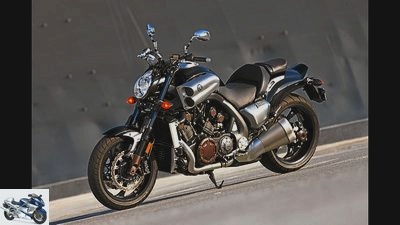
archive

Stefan Wolf
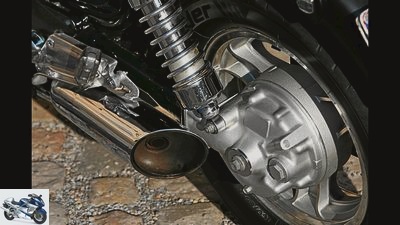
Stefan Wolf
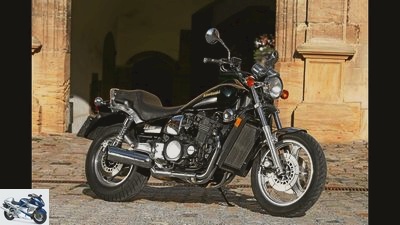
Stefan Wolf

Stefan Wolf
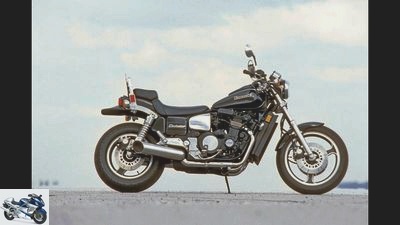
Stefan Wolf
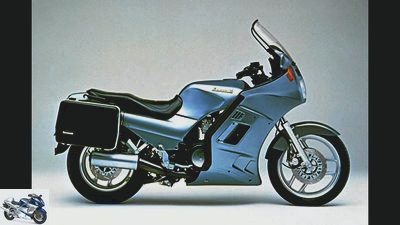
Stefan Wolf
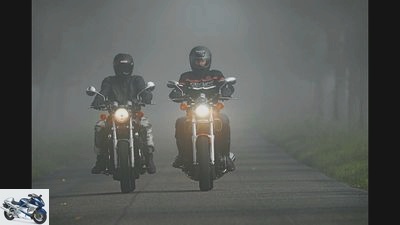
Stefan Wolf
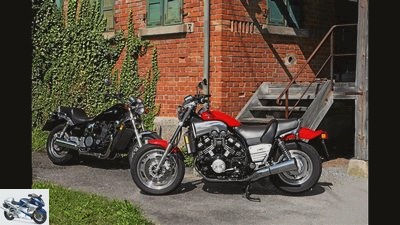
Stefan Wolf

Stefan Wolf
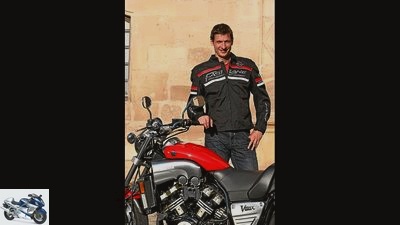
Stefan Wolf
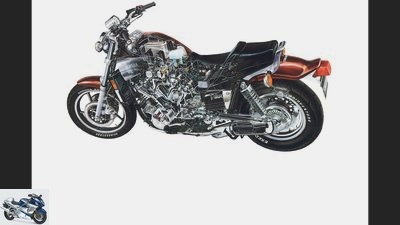
Stefan Wolf
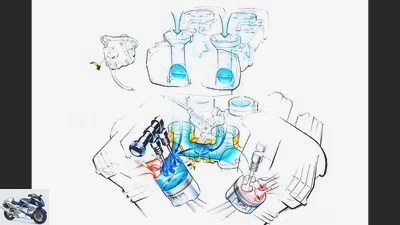
Stefan Wolf
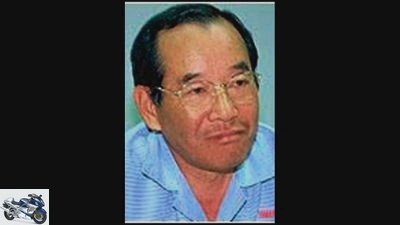
archive
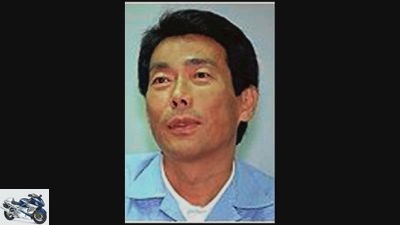
archive

archive

archive
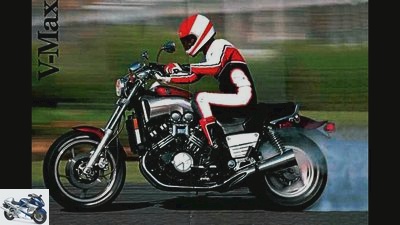
archive
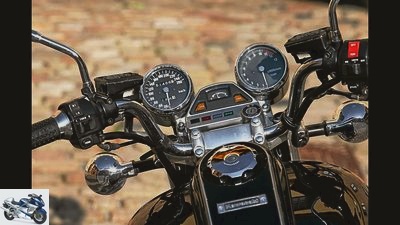
Stefan Wolf
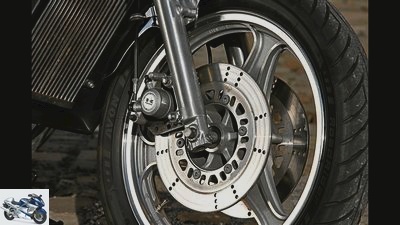
Stefan Wolf

Stefan Wolf
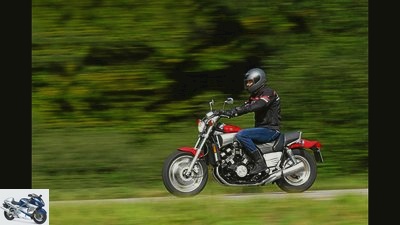
Stefan Wolf
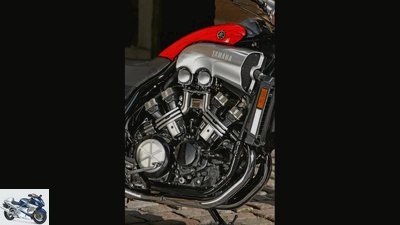
Stefan Wolf

Stefan Wolf

Stefan Wolf

Stefan Wolf

Stefan Wolf
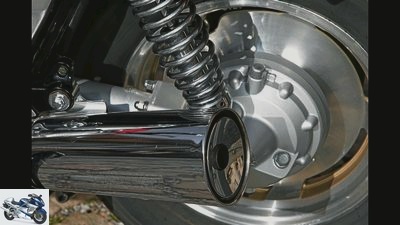
Stefan Wolf
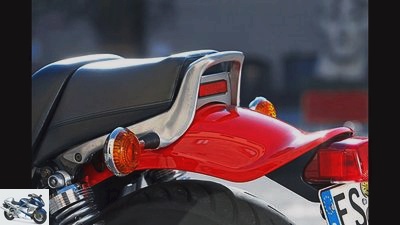
Stefan Wolf
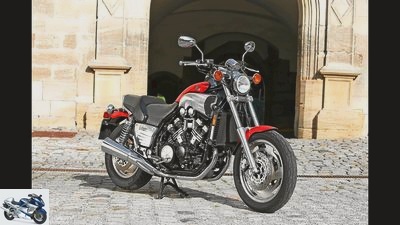
Stefan Wolf
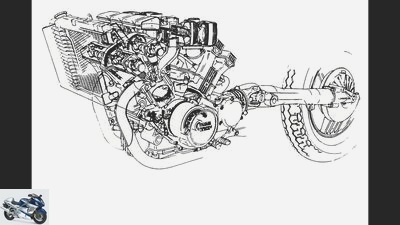
Stefan Wolf
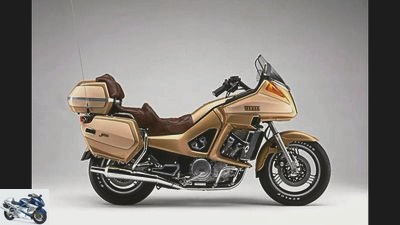
Stefan Wolf
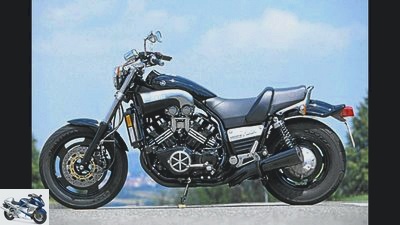
Stefan Wolf
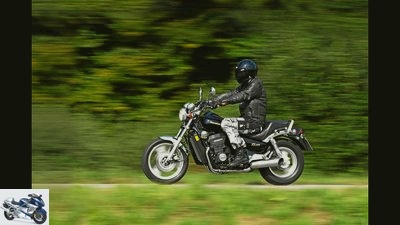
Stefan Wolf
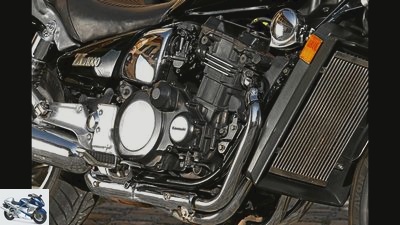
Stefan Wolf
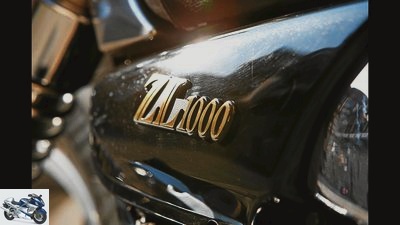
Stefan Wolf
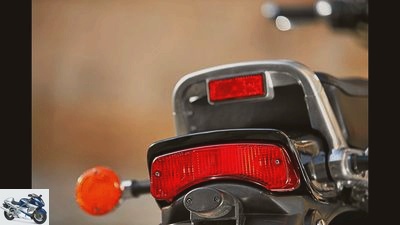
Stefan Wolf

archive




38 photos
Pictures: On the road with Kawasaki ZL 1000 and Yamaha Vmax
To home page

archive

Stefan Wolf

Stefan Wolf

Stefan Wolf

Stefan Wolf

Stefan Wolf

Stefan Wolf

Stefan Wolf

Stefan Wolf

Stefan Wolf

Stefan Wolf

Stefan Wolf

Stefan Wolf

archive

archive

archive

archive

archive

Stefan Wolf

Stefan Wolf

Stefan Wolf

Stefan Wolf

Stefan Wolf

Stefan Wolf

Stefan Wolf

Stefan Wolf

Stefan Wolf

Stefan Wolf

Stefan Wolf

Stefan Wolf

Stefan Wolf

Stefan Wolf

Stefan Wolf

Stefan Wolf

Stefan Wolf

Stefan Wolf

Stefan Wolf

archive
30 years of Yamaha Vmax




10 photos
Pictures: On the road with Kawasaki ZL 1000 and Yamaha Vmax
To home page

Markus Jahn

Markus Jahn
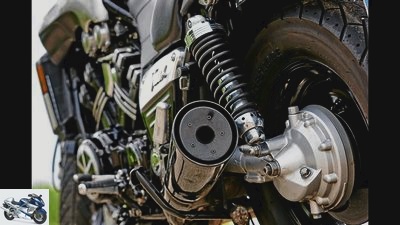
Markus Jahn
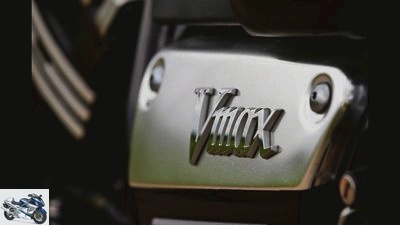
Markus Jahn
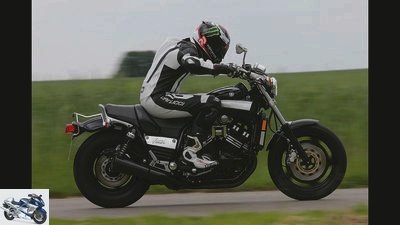
Markus Jahn
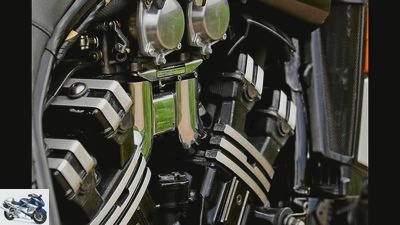
Markus Jahn
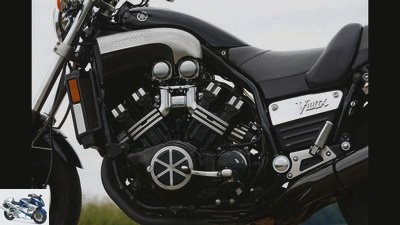
Markus Jahn
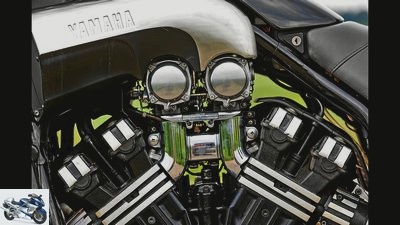
Markus Jahn
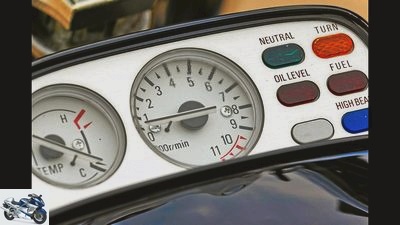
Markus Jahn
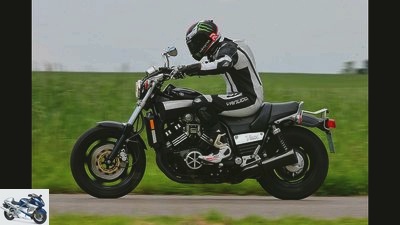
Markus Jahn
Related articles
-
Kawasaki Versys 1000 driving report
Wright Driving report: Kawasaki Versys 1000 (with video) Kawasaki’s all-rounder now with a large four-cylinder No half measures: For the Versys there is…
-
On the move with Kawasaki GPZ 900 R and Yamaha FJ 1100
fact 39 photos fact 1/39 Hurry with a while, always slowly with the young horses – sayings like these were definitely not up for debate when the new,…
-
BMW R 90 S, Kawasaki 900 Z1, Laverda 1000 3C Big Bikes
fact 30th photos fact 1/30 Big bike classics from the 70s – pure fascination. Kawasaki 900 Z1, Laverda 1000 3C and BMW R 90 S driven by MOTORRAD Classic….
-
BMW F 800 R, Kawasaki Z 800, MV Agusta Brutale 800 and Yamaha FZ8 in the test
Jahn 29 photos Jahn 1/29 A comparison of four 800 class motorcycles: BMW F 800 R, Kawasaki Z 800, MV Agusta Brutale 800 and Yamaha FZ8. Jahn 2/29 Like…
-
Comparison test: Ducati Diavel, Suzuki B-King and Yamaha Vmax
Jahn comparison test: Power Bikes 2011 Ducati Diavel, Suzuki B-King and Yamaha Vmax Content from Big appearance, powerful sound waves, pressure from all …
-
Jahn comparison test Powercruiser Kawasaki VN 2000, Suzuki Intruder M 1800 R, Yamaha XV 1900 Midnight Star Punchtime Nobody distributes more displacement and …
-
Comparison test Harley-Davidson Fat Boy, Kawasaki 1500 VN, Yamaha XVZ 1300 A
Comparison test, Harley-Davidson Fat Boy, Kawasaki VN 1500 Classic, Yamaha XVZ 1300 A Royal Star Harley-Davidson Fat Boy, Kawasaki 1500 VN, Yamaha XVZ …
-
On the move with a Kawasaki Z 1000 and Zephyr 1100
www.bilski-fotografie.de 36 photos www.bilski-fotografie.de 1/36 Genetically not related, but they belong to the same family: Kawasaki Z 1000 and Zephyr…
-
On the move with the Honda CB 900 F Bol d‘Or, Honda CBX, Kawasaki Z 1000 ST and Kawasaki Z 1300
Arturo Rivas 45 photos Arturo Rivas 1/45 Six against four for the first: Honda CBX and Honda CB 900 Bol d’Or. Arturo Rivas 2/45 Honda CBX. Arturo Rivas…
-
Kawasaki Versys 1000 – The four-cylinder tourer
Gargolov Test: Kawasaki Versys 1000 The four-cylinder tourer from Kawasaki Cover long distances in a relaxed manner with a pillion passenger and a lot of…